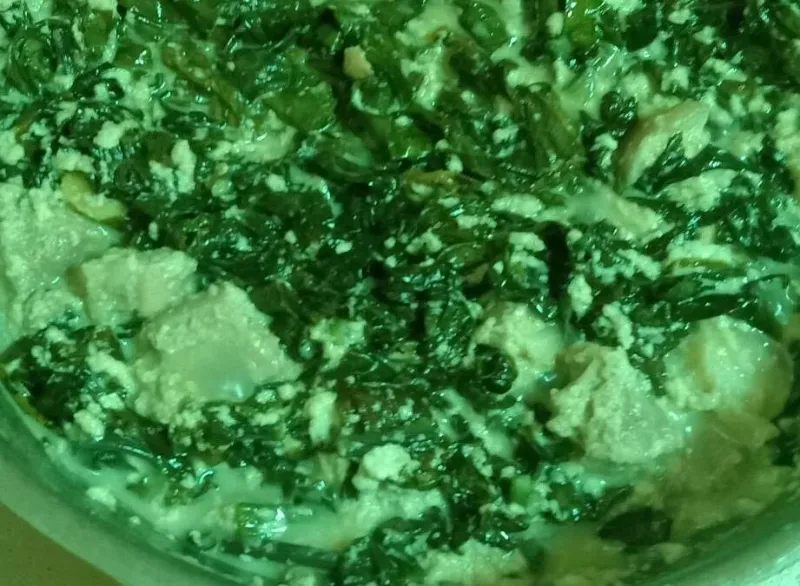Ginataang Laing, also known as Linagang Katnga, is a traditional Filipino dish originating from the Bicol region. The dish is made using shredded and dried taro leaves, which are simmered in coconut milk, pork belly or tinapa (smoked fish), bagoong alamang (shrimp paste), chili peppers, and spices. The name “Laing” is derived from the Tagalog word for dried leaves.
One of the unique features of Ginataang Laing is that the taro leaves are boiled until the coconut milk thickens and produces an oily curd. This process results in a deliciously flavorful and creamy texture that pleases the taste buds. Using coconut milk in the recipe adds a rich and creamy flavor to the dish and complements the spiciness of the chili peppers.
This recipe is just one of the prides of the people of Bicol and has become a popular delicacy throughout the Philippines. It is a staple dish in many Filipino households and is often served as a main dish with rice. Ginataang Laing can also be paired with Filipino dishes such as fried fish, grilled pork, or chicken adobo.
The use of taro leaves in Ginataang Laing is flavorful and healthy. Taro leaves are a good source of fiber and vitamins such as Vitamin A and C. Coconut milk is also a good source of healthy fats known for its immune-boosting properties.
Overall, Ginataang Laing is a delicious and nutritious dish that highlights the flavors of the Bicol region. Its unique combination of taro leaves, coconut milk, and spices creates a flavorful dish that satisfies the appetite. It’s a must-try for anyone looking to experience the rich flavors of Filipino cuisine.
Ingredients: 3-4 servings
1 bundle dried taro leaves (4 oz. in a bag)
2 whole tinapa or dried fish
2 cloves minced garlic
1/2 medium sliced onion
1 thumb sized, minced ginger
1/2 tsp bagoong alamang(shrimp paste)
1 large can(8 oz.) of coconut milk
2-3 pieces, sliced siling labuyo(red chili peppers)
salt & pepper to taste
1 cup water
Important note: The emphasis of using dried taro leaves in cooking laing is important. Taro leaves when young or fresh contain a toxin that cause itch to your throat when eaten. Drying the leaves by leaving them in the sun until dried, eliminates substance causing the itching reactions from the leaves. At least that’s what we learned from our old folks!
Cooking Procedure:
- Thoroughly but gently clean dried taro leaves if bought in bundle(some can be purchased already shredded in bags), and shred in small pieces. Set aside.
- Wash off excess salt tinapa or dried fish through running water. Pat dry water if needed. If you’re adding tinapa to the dish, devein and shred it, if it’s dried fish, use a knife to strip them into thin sliced. Do the same with bagoong(shrimp paste) by placing bagoong on a strainer, then run water through.
- Pour coconut milk onto over a deep pot, add water, drop onions, garlic, ginger, bagoong and dried fish or tinapa. Stir ingredients to evenly combine. Place cooking pot on a heated stove, and set it over medium temperature.
- Bring coconut milk in to boil, while constantly stirring. Let it simmer for 10-15 minutes or until coconut milk slightly thickens. Season with crushed black peppers. Apply a pinch of salt if desired.
- Throw entire dried taro leaves on the pan, add sliced chili peppers(labuyo), stir to fully combine ingredients. Let it boil and simmer over low heat for 15-25 minutes, or until Laing or Ginataang Laing is cooked. Laing should be soft to try when cooked.
- Turn off the heat and transfer on a large bowl. Serve delicious, coconut milk taro leaves with steamed rice. Pour 2-4 tablespoon of vinegar, a pinch of salt or 1/4 teaspoon of fish sauce as a condiment.
Tip: Best tasting Laing is when coconut milk is heavily thickened and almost drained. There’s also a visual appearance of oil substance beaming all over the dish, slight coconut milk curding on top, and the right level of seasoning, when taste-tested is perfect. Love it or leave it!


